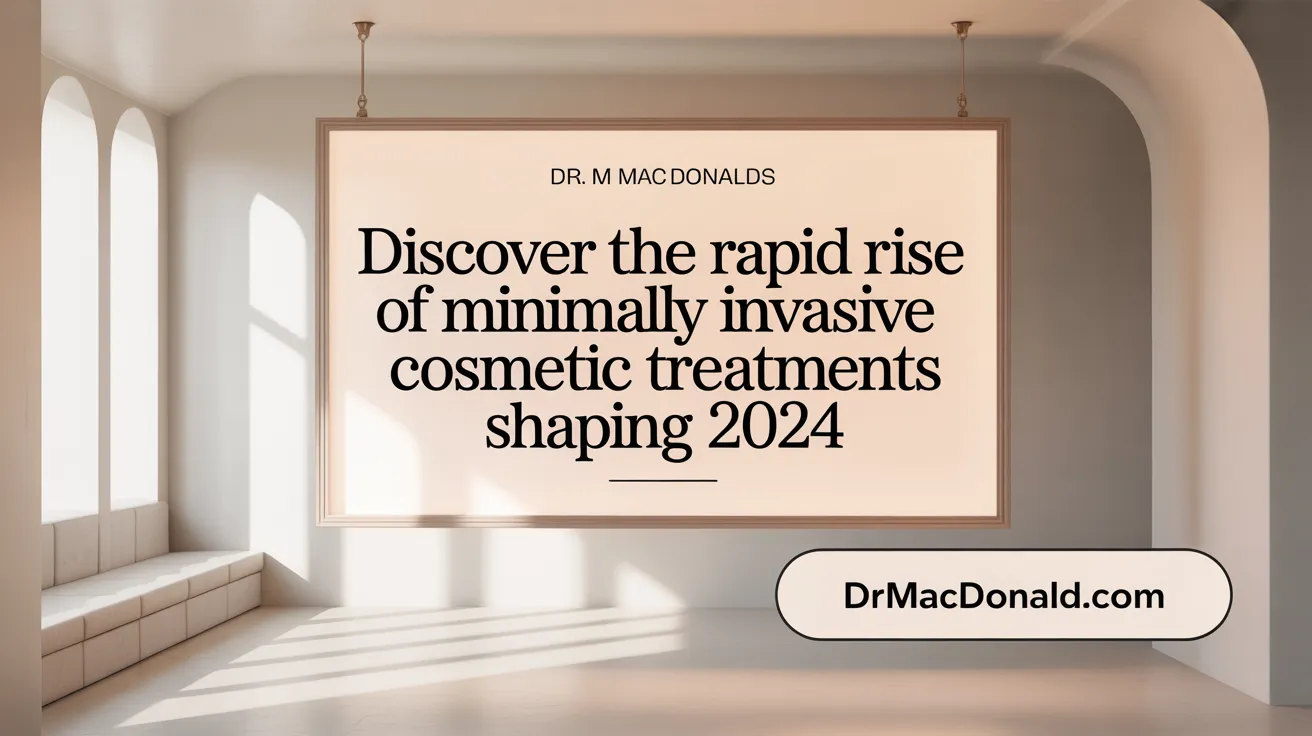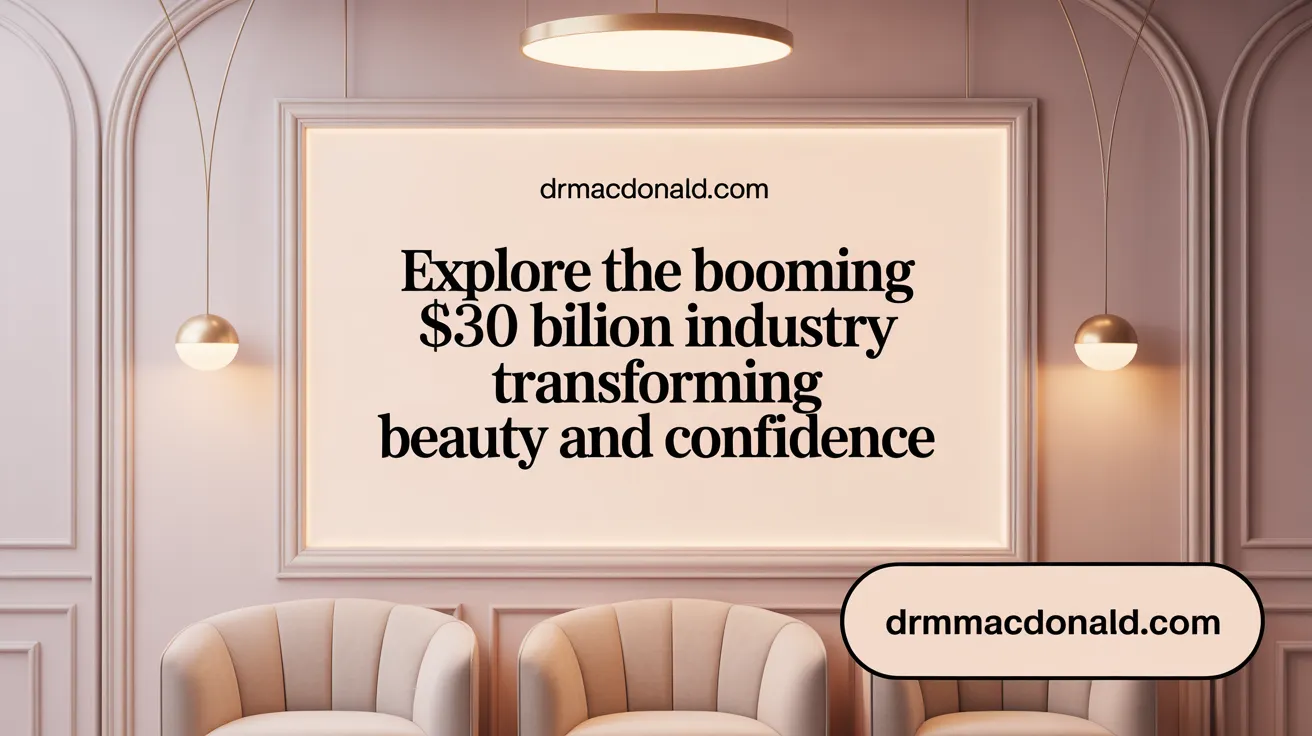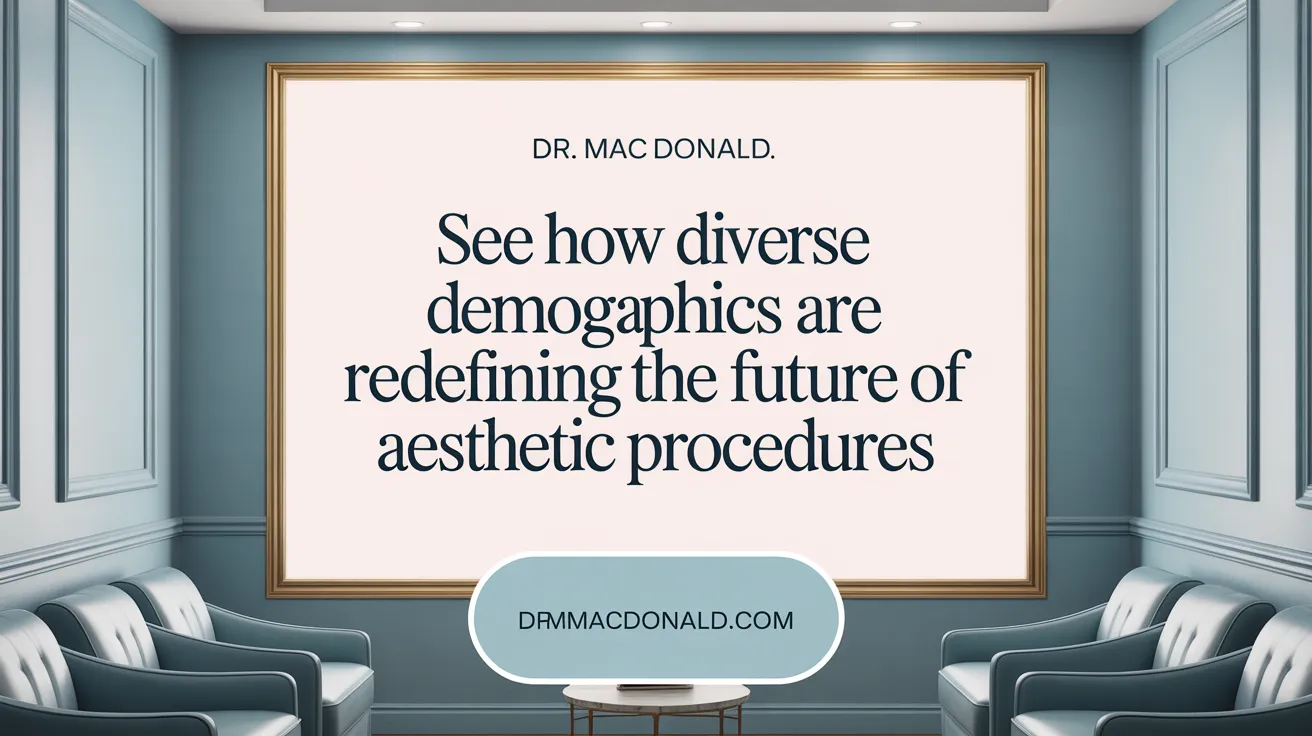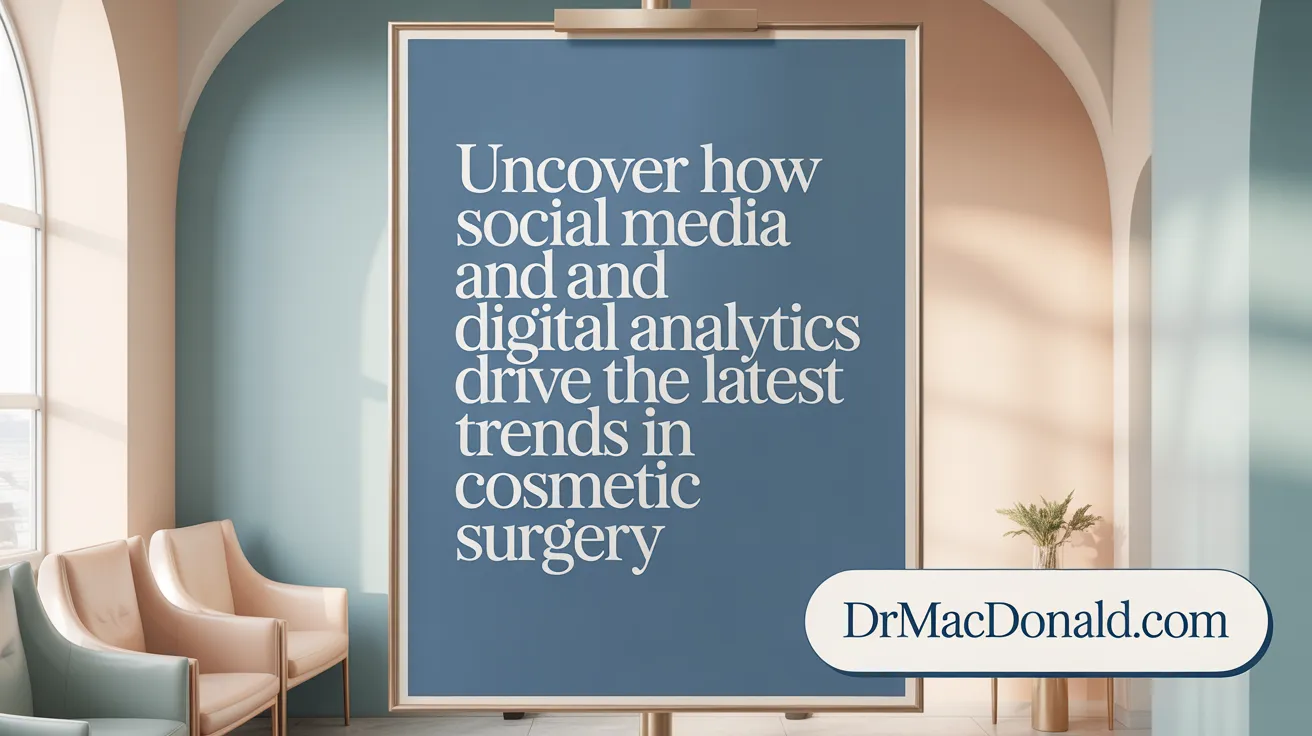The Rising Wave of Cosmetic Enhancements
The medical aesthetics industry is witnessing unprecedented growth, fueled by innovations in minimally invasive procedures, evolving consumer preferences, and the expanding availability of cosmetic treatments. This article provides a comprehensive, data-driven overview of cosmetic enhancements, illustrating the significant trends, demographic shifts, and economic dynamics shaping the industry today and moving forward.
Explosive Growth in Minimally Invasive Cosmetic Procedures

How has the minimally invasive cosmetic procedures market grown over time?
The minimally invasive cosmetic procedures market growth has experienced remarkable expansion over the past two decades. From 1997 to 2013, the total number of non-surgical cosmetic treatments surged by over 500%. This significant growth is highlighted by the rise in botulinum toxin procedures, which increased by 759% since 2000. By 2015, Americans underwent 14.2 million minimally invasive cosmetic procedures, demonstrating the widespread acceptance and demand for these treatments (Medical Aesthetics Industry Statistics).
What are the most common minimally invasive cosmetic procedures?
Among the minimally invasive options, botulinum toxin type A injections dominate the market, with 6.7 million procedures performed in 2015 alone. Soft tissue fillers follow with 2.4 million procedures, showing a 274% increase since 2000. Chemical peels and laser hair removal also contribute significantly, with 1.3 million and 1.1 million procedures respectively in 2015, reflecting steady growth in their adoption (Medical Aesthetics Industry Statistics.
Industry growth projections
The market is projected to continue its upward trajectory, with Americans spending over $16 billion on cosmetic procedures in recent years and forecasts estimating an annual expenditure of $30 billion by 2030. This robust growth is mirrored in the expansion of medspas, expected to reach 15,000 locations across the United States by 2030, making the industry increasingly accessible to a broader audience (minimally invasive cosmetic procedures market growth, Medical Aesthetics Industry Statistics.
Overall, these trends indicate a strong and sustained interest in minimally invasive cosmetic procedures, driven by their efficacy, minimal downtime, and growing social acceptance (Plastic Surgery Demand in 2024).
Economic Impact and Market Size of Medical Aesthetics

What is the current market size and projected growth for cosmetic procedures in the U.S.?
In recent years, Americans have devoted substantial funds to cosmetic procedures, with spending surpassing $16 billion in the last year alone. Projections indicate that this market will nearly double, reaching $30 billion annually by 2030. This surge is supported by the rapid expansion of the medical aesthetics industry, including the expected rise in the number of medspas to 15,000 across the United States by 2030 (Medical Aesthetics Industry Statistics, Growth of Cosmetic Procedures Market, Minimally-Invasive Cosmetic Procedures in 2015.
How does economic uncertainty affect patient demand for aesthetic treatments?
Interestingly, the medical aesthetics field has displayed remarkable resilience amidst economic uncertainties. Data from 2024 show that despite financial challenges, the demand for aesthetic procedures has remained strong. Patients continue to prioritize cosmetic health, reflecting a persistent desire for enhancements even during fluctuating economic conditions (Plastic Surgery Procedure Statistics, Plastic Surgery Trends).
Trends and Financial Insights
- Non-surgical procedures account for a significant portion of the market, representing 42% of total cosmetic expenditures and exceeding $5 billion (Medical Aesthetics Industry Statistics, Growth in Non-Surgical Cosmetic Treatments.
- Injectables, particularly botulinum toxin and hyaluronic acid treatments, form a sizable share of spending, with over $2.5 billion invested (Medical Aesthetics Industry Statistics, Botulinum Toxin and Hyaluronic Acid Popularity.
- Minimally invasive procedures are favored for their quick results and minimal downtime, attracting a broadening demographic including more male clients (Plastic Surgery Demand in 2024, Men's Acceptance of Minimally Invasive Procedures.
The sustained growth and economic resilience highlight an industry with deep consumer commitment, poised for continuous expansion in the coming decade.
Demographic and Gender Shifts in Cosmetic Enhancements

Which demographics are increasingly opting for cosmetic procedures?
Cosmetic enhancements continue to attract a diverse demographic, with notable growth among men and older adults. Men are increasingly embracing minimally invasive treatments like Botox and laser procedures, reflecting broader acceptance beyond traditional female clientele (Men's Acceptance of Minimally Invasive Procedures, Laser and Botox Use Among Men. The patient age demographic is wide-ranging, with a significant portion falling between 35 and 50 years old (Patient Age Groups in Plastic Surgery. Moreover, individuals aged 55 and above show growing interest in procedures targeting natural aging signs, especially facial and neck lifts (Plastic Surgery Demand in 2024.
What are popular procedures among men and older adults?
Gynecomastia surgery, or male breast reduction, ranks as the top cosmetic procedure for men, aligning with a trend toward natural-looking results (Male Breast Surgery Trends, Gynaecomastia Surgery Popularity. Older adults, particularly those over 55, are gravitating towards facial rejuvenation and neck lift surgeries, prioritizing long-lasting outcomes that maintain a natural appearance (Facial Rejuvenation Procedures for Older Adults, Facial and Neck Lifts Growth. This demographic shift underscores evolving preferences and expands the scope of cosmetic enhancements beyond the younger population.
These trends reflect changing societal attitudes and the influence of minimally invasive technologies offering quick recovery and subtle improvements (Growth in Non-Surgical Cosmetic Treatments, Minimally-Invasive Cosmetic Procedures in 2015. As cosmetic procedures grow in popularity across various age groups and genders, the industry adapts to meet these emerging demands (Plastic Surgery Procedure Statistics.
Influences Shaping Public Interest in Aesthetic Surgery

How has social media influenced public interest in cosmetic procedures?
Social media platforms, especially Instagram, have played a pivotal role in boosting public interest in aesthetic surgery. Since around 2012, there has been a notable surge in online searches for various cosmetic procedures such as blepharoplasty, Botox, lip augmentation, rhinoplasty, and more. This rise corresponds with Instagram’s growth as a highly visual platform where aesthetic results and personal transformations are widely shared, inspiring many to explore these medical enhancements (Plastic Surgery Trends, Rise of Instagram, Aesthetic Procedures Interest; impact of social media on aesthetic surgery demand.
What analytic methods confirm changes in aesthetic surgery interest?
Researchers utilized Google Trends data to analyze public search behavior related to plastic surgery procedures. By employing bivariate regression analysis, they identified statistically significant increases in search volume for many procedures. This method provided strong evidence that social media exposure directly influences patients' curiosity and their decisions to pursue cosmetic treatments (Plastic Surgery Trends, Rise of Instagram, Aesthetic Procedures Interest).
Top procedures influenced by online trends
The procedures most impacted by heightened online visibility include:
- Blepharoplasty (eyelid surgery)
- Botox injections
- Lip augmentation
- Rhinoplasty (nose reshaping)
- Hair transplantation
These treatments gained popularity partly due to their frequent display in social media content and endorsements by influencers, which helped demystify options and set new beauty standards (Plastic Surgery Trends, Rise of Instagram, Aesthetic Procedures Interest; Plastic Surgery Demand in 2024.
Data analytics and public search behavior
The use of big data tools like Google Trends offers insights into shifting public interests over time. While exact surgery numbers cannot be directly inferred from search volume alone, combining these analytics with clinical and industry reports provides a comprehensive picture of evolving demand. This data-driven understanding helps providers anticipate patient priorities and tailor their offerings in a dynamic digital environment (Plastic Surgery Trends, Rise of Instagram, Aesthetic Procedures Interest; Plastic Surgery Demand in 2024.
Comprehensive Plastic Surgery Landscape in 2024
What are the most performed surgical cosmetic procedures in the current year?
Liposuction remains the most popular cosmetic surgery in 2024, followed closely by breast augmentation, tummy tuck, breast lift, and eyelid surgery. These procedures highlight ongoing patient interest in body contouring and facial rejuvenation, providing enhancements that combine aesthetic appeal with natural-looking results. (Plastic Surgery Demand in 2024
Which regions perform the highest number of cosmetic procedures?
The South Atlantic region leads the United States in cosmetic surgery volume, accounting for 28% of all procedures. Within this region, Brazilian butt lifts and liposuction are especially common, reflecting regional preferences and availability of specialized surgical expertise. (Plastic Surgery Demand in 2024
How do reconstructive procedures fit into the aesthetic landscape?
Reconstructive surgeries experienced a 2% growth in 2024, demonstrating their important role beyond cosmetic enhancement. Patients of various age groups seek these interventions to improve quality of life and mental well-being, emphasizing the broader health benefits of plastic surgery. (Plastic Surgery Demand in 2024
Evolving trends amidst advancing technologies
Minimally invasive treatments continue to complement surgical procedures with options like neuromodulator injections (Botox) and fillers offering quick results and minimal downtime. Additionally, the incorporation of prescription weight loss medications and body contouring is influencing body contouring approaches, with plastic surgeons playing a key role in post-weight-loss aesthetic transformation. (Plastic Surgery Demand in 2024
Together, these trends indicate a robust and dynamic plastic surgery market in 2024, balancing surgical and non-surgical options tailored to diverse patient needs and preferences. (Plastic Surgery Demand in 2024
The Future of Medical Aesthetics
Data clearly shows that medical aesthetics is a dynamic and rapidly evolving field marked by increasing consumer acceptance, an expanding procedural repertoire, and robust economic growth. Emerging demographic trends and the powerful influence of digital media platforms are reshaping public perceptions and driving demand. With minimally invasive procedures gaining popularity alongside established surgical options, the medical aesthetics industry is on a promising trajectory to meet diverse patient needs with innovative, personalized care.
